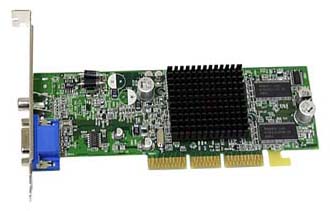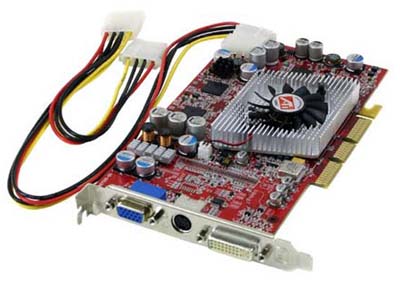Buyer's Guide - Entry Level, October 2004
by Jarred Walton on October 6, 2004 12:05 AM EST- Posted in
- Guides
Video Cards
We mentioned earlier on the motherboard selection that you might look for a solution with integrated graphics. We do not recommend it, but you can save about $20 should you choose to go that route. We prefer to go with an add-in graphics card and avoid integrated solutions. Part of the reason for this is drivers, since getting up-to-date drivers for integrated graphics solutions can often be difficult. It is easier to find drivers for Intel, NVIDIA, and ATI solutions, but the ATI and Intel options are currently only available for Pentium 4/Celeron platforms. However, we still prefer the quality and reliability of the discreet graphics cards manufactured by ATI and NVIDIA.
Office Graphics Recommendation: Celestica Radeon 9200SE 64MB DDR
Price: $35 shipped
The Radeon 9200SE continues to provide the best price for anyone looking for a cheap, but reliable, graphics card. Nearly all of the Radeon and GeForce graphics cards use the reference design, so quality and stability are very good. For non-gaming use, it really does not matter too much what type of graphics card you use. So, those who prefer something other than an ATI card might look to the GeForce 4MX cards or even FX5200 - although the latter costs a little more. Reliability of any of these cards is very good, as is the driver support. Just do not expect much in the way of performance should you try to fire up a 3D application.

Gaming Graphics Recommendation: Connect3D ATI Radeon 9800 Pro 128MB DDR, 256-bit
Price: $195 shipped
The price of our suggested "Budget Gamer" graphics card may seem somewhat out of line with the rest of the choices, but you really have to look at the bigger picture. With pretty much any moderate CPU, the bottleneck in games is going to be your graphics card. Personally, we would recommend that you save a bit of money on the CPU in order to upgrade your graphics card rather than the other way around. A P4 560 (3.6 GHz)/3500+ A64 processor will still struggle to run games when paired with a low-end graphics card, while a moderate 2.4 GHz Celeron D/2400+ Sempron will be sufficient for almost any game when paired with a mid-range graphics card. If you cannot afford $200 for a graphics card and you want to be able to play games for at least another year on your PC, you are better off saving up money for a few more months rather than settling for a cheaper alternative.
Within that $200 price range, there are many options for the budget gamer, and several new cards should be available within the next month that are worth waiting for. We are talking about the NVIDIA 6600GT and the ATI X700XT, which we have recently previewed. Unfortunately, you will need to wait for AGP versions if you want to stay with the rest of our budget configuration, which means that it might be two months or more before they are available. Of course, there is always something better coming out in the next few months - by the time the 6600 and X700 arrive, the latest buzz will be about the soon-to-be-released Spring graphics chips.
If you cannot wait that long and you still want a good gaming graphics card, the Radeon 9800 Pro continues to provide great performance for the price. Our initial previews of the 6600GT and X700XT show that while they will be generally faster than the 9800 Pro, the margin is not that great. This is not too surprising, considering that they all have eight pixel rendering pipelines. The 9800 Pro falls behind in core clock speed, but it makes up for it in memory bandwidth, resulting in relative performance that can fluctuate by up to 20% in either direction. Overall, the price is about the same on all the cards, but you can go out and purchase the Radeon 9800 Pro today.
Other options for the budget gamer include the 9600 Pro and 9600 XT, along with the FX5900 XT. Longevity is a pretty major concern with all of those, but they should suffice if you are not too demanding. If you are a more serious gamer and can actually spend the money, there are much faster cards available, which can improve performance further, but their prices do not fit the budget category. We recommend that you take a look at our other Buyer's Guides for further input.










53 Comments
View All Comments
kmmatney - Wednesday, October 6, 2004 - link
We are going completely small form factor at my office, using either the ASUS Terminator or, lately, ASUS T2-P with Celeron-D. They've all worked great, and no problems using on-board graphics.The ASUS Terminator + Duron is simply an incredible value. The ASUS T2-R is also nice, with ATI Radeon 9100 graophics.
kherman - Wednesday, October 6, 2004 - link
kherman - Wednesday, October 6, 2004 - link
Left kinda confused. I see alot of areas I simply didn't like. In particular, for a true Office rig, where data intergretty is VERY important, I'd suggest 2 hard drives and a software RAID solution. Same total cost for hard drives, but it's justfied in terms of budget. Spend the same amount. for gaming, go for fast loading. For office, go for redundancy. The Office rig would actually have more alloted to the hard drive, but isn't that the critical component in an office rig?I say this every time I see a write up. You really need to start mentioning it, even if it's simpyl an alternative office solution that costs more. Most people using a PC for home office use, don't have a server running RAID 5 available and it almost seems as though it's an assumption.
Other than this, I loved that article. Also, for home office, I can't see recomending 17" monitors. You need to generally run higher resolution and see more of the screen to be efficient in a home office.
To be honest, I have to say that "a "budget rig" for office shouldn't be much cheaper than he gaming rig. Monitors and redundancy are important factors here where gaming rigs need a killer video card.
Please consider this in the future.
boomerang - Wednesday, October 6, 2004 - link
Very happy with the more in-depth explanations and choices given in the guide. I very much depend on these guides when building systems.You are to be commended for a job well done!
iversonyin - Wednesday, October 6, 2004 - link
since we in the entry level budget, why not get a generic case+ PS. generic case usually got for ~$35i would not run XP with 256 MB RAM even its only for office use. IMO
PrinceGaz - Wednesday, October 6, 2004 - link
On the last page in the Additional Alternatives table, the Power Supply Upgrade has the wrong item name.Iger - Wednesday, October 6, 2004 - link
Thanks for the nice guide, I love explanations too :)About monitors - there actually are Samsung 795 DF ones, which handle 1280x1024@75 for a few more $ :)
Gholam - Wednesday, October 6, 2004 - link
$14, Bayfield is just way too expensive - why not use a D865GVHZ if you're determined to go Intel?Gholam - Wednesday, October 6, 2004 - link
$14, Bayfield is just way too expensive - why not use a D865GVHZ if you're determined to go Intel?Scarceas - Wednesday, October 6, 2004 - link
I've had seen at least one business app that didn't run right on an nForce motherboard. It was wierd.Anyway, I never seem to have any trouble with stability or configuration when using an Intel-branded motherboard with an Intel CPU.
It does cost a bit more, but the in the total cost of ownership equation, the hardware itself is definitely not the largest factor, especially on a budget near this one.
The previously mentioned application is a good case in point: the money saved in hardware was easily ate up in service/support to troubleshoot the program.
I like the Intel D865GBFL motherboard, and if you're going budget, a Celeron D 320 will fit nicely ($165 shipped from Newegg).
In an office environment, the performance delta is not so critical, and I don't mind spending $35 more if it reduces support issues.
Just something to conside...